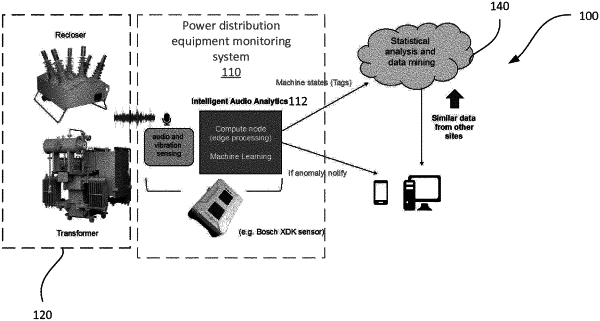| CPC G01R 31/62 (2020.01) [G06N 3/08 (2013.01); H02J 13/00002 (2020.01)] | 17 Claims |

|
1. A power distribution equipment monitoring system comprising:
a plurality of sensing assemblies, each sensing assembly being configured for incorporation in, onto or proximate a respective power distribution equipment of a plurality of power distribution equipment arranged at various different locations, the plurality of power distribution equipment including at least one of a transformer, a regulator, a chiller, and a recloser, each of the plurality of sensing assemblies being configured to output respective sensor signals indicative of sounds and/or vibrations from the respective power distribution equipment; and
an intelligent audio analytic (IAA) device configured to receive the sensor signals from the plurality of sensing assemblies, to process the sensor signals to detect anomalies from operation of the at least one power distribution equipment, and to output detection information to an output device to alert an operator of detection of any anomalies, the IAA including programmed instructions stored on a non-transitory computer readable storage medium and a processor configured to execute the programmed instructions, the programmed instructions including an analytics algorithm for execution by the processor to continuously process the sensor signals to detect the anomalies,
wherein the analytics algorithm includes at least one neural network, an autoencoder neural network, the autoencoder neural network being configured to receive the respective sensor signals as input and to output respective reconstructed sensor signals based on the input, and
wherein the processor is configured to (i) generate respective error signals that are indicative of a difference between the input and the output of the autoencoder neural network for the respective sensor signals, (ii) detect anomalies based on a magnitude of the respective error signal, and (iii) perform spatio-temporal analysis of load distribution impacts on the plurality of power distribution equipment by aggregating results from the plurality of power distribution equipment arranged at the various different locations.
|